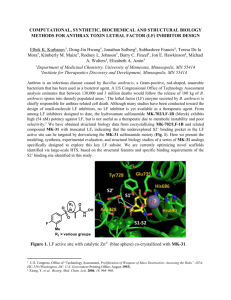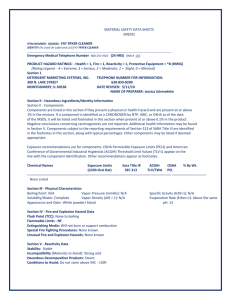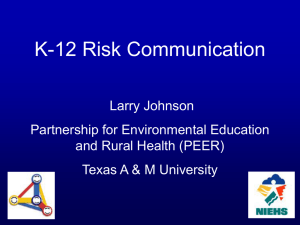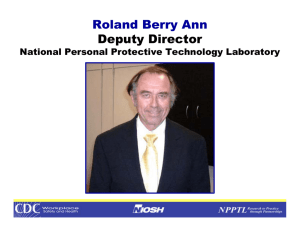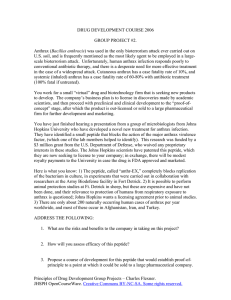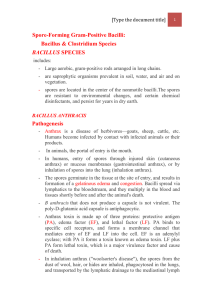Bacillus anthracis Update on Personal Protective Equipment Recommendations for Response to
advertisement
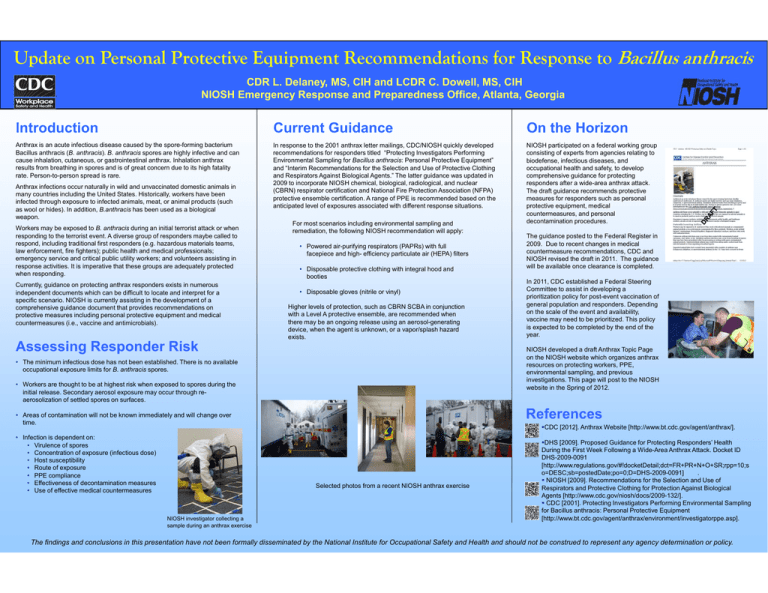
Update on Personal Protective Equipment Recommendations for Response to Bacillus anthracis CDR L. Delaney, MS, CIH and LCDR C. Dowell, MS, CIH NIOSH Emergency Response and Preparedness Office, Atlanta, Georgia Introduction Current Guidance On the Horizon Anthrax is an acute infectious disease caused by the spore-forming bacterium Bacillus anthracis (B. anthracis). B. anthracis spores are highly infective and can cause inhalation, cutaneous, or gastrointestinal anthrax. Inhalation anthrax results from breathing in spores and is of great concern due to its high fatality rate. Person-to-person spread is rare. In response to the 2001 anthrax letter mailings, CDC/NIOSH quickly developed recommendations for responders titled “Protecting Investigators Performing Environmental Sampling for Bacillus anthracis: Personal Protective Equipment” and “Interim Recommendations for the Selection and Use of Protective Clothing and Respirators Against Biological Agents.” The latter guidance was updated in 2009 to incorporate NIOSH chemical, biological, radiological, and nuclear (CBRN) respirator certification and National Fire Protection Association (NFPA) protective ensemble certification. A range of PPE is recommended based on the anticipated level of exposures associated with different response situations. NIOSH participated on a federal working group consisting of experts from agencies relating to biodefense, infectious diseases, and occupational health and safety, to develop comprehensive guidance for protecting responders after a wide-area anthrax attack. The draft guidance recommends protective measures for responders such as personal protective equipment, medical countermeasures, and personal decontamination procedures. Anthrax infections occur naturally in wild and unvaccinated domestic animals in many countries including the United States. Historically, workers have been infected through exposure to infected animals, meat, or animal products (such as wool or hides). In addition, B.anthracis has been used as a biological weapon. Workers may be exposed to B. anthracis during an initial terrorist attack or when responding to the terrorist event. A diverse group of responders maybe called to respond, including traditional first responders (e.g. hazardous materials teams, law enforcement, fire fighters); public health and medical professionals; emergency service and critical public utility workers; and volunteers assisting in response activities. It is imperative that these groups are adequately protected when responding. Currently, guidance on protecting anthrax responders exists in numerous independent documents which can be difficult to locate and interpret for a specific scenario. NIOSH is currently assisting in the development of a comprehensive guidance document that provides recommendations on protective measures including personal protective equipment and medical countermeasures (i.e., vaccine and antimicrobials). For most scenarios including environmental sampling and remediation, the following NIOSH recommendation will apply: • Powered air-purifying respirators (PAPRs) with full facepiece and high- efficiency particulate air (HEPA) filters • Disposable protective clothing with integral hood and booties • Disposable gloves (nitrile or vinyl) Higher levels of protection, such as CBRN SCBA in conjunction with a Level A protective ensemble, are recommended when there may be an ongoing release using an aerosol-generating device, when the agent is unknown, or a vapor/splash hazard exists. Assessing Responder Risk • Workers are thought to be at highest risk when exposed to spores during the initial release. Secondary aerosol exposure may occur through reaerosolization of settled spores on surfaces. References • Areas of contamination will not be known immediately and will change over time. Selected photos from a recent NIOSH anthrax exercise NIOSH investigator collecting a sample during an anthrax exercise In 2011, CDC established a Federal Steering Committee to assist in developing a prioritization policy for post-event vaccination of general population and responders. Depending on the scale of the event and availability, vaccine may need to be prioritized. This policy is expected to be completed by the end of the year. NIOSH developed a draft Anthrax Topic Page on the NIOSH website which organizes anthrax resources on protecting workers, PPE, environmental sampling, and previous investigations. This page will post to the NIOSH website in the Spring of 2012. • The minimum infectious dose has not been established. There is no available occupational exposure limits for B. anthracis spores. • Infection is dependent on: • Virulence of spores • Concentration of exposure (infectious dose) • Host susceptibility • Route of exposure • PPE compliance • Effectiveness of decontamination measures • Use of effective medical countermeasures The guidance posted to the Federal Register in 2009. Due to recent changes in medical countermeasure recommendations, CDC and NIOSH revised the draft in 2011. The guidance will be available once clearance is completed. CDC [2012]. Anthrax Website [http://www.bt.cdc.gov/agent/anthrax/]. / DHS [2009]. Proposed Guidance for Protecting Responders’ Health During the First Week Following a Wide-Area Anthrax Attack. Docket ID DHS-2009-0091 [http://www.regulations.gov/#!docketDetail;dct=FR+PR+N+O+SR;rpp=10;s o=DESC;sb=postedDate;po=0;D=DHS-2009-0091] . NIOSH [2009]. Recommendations for the Selection and Use of Respirators and Protective Clothing for Protection Against Biological Agents [http://www.cdc.gov/niosh/docs/2009-132/]. CDC [2001]. Protecting Investigators Performing Environmental Sampling for Bacillus anthracis: Personal Protective Equipment [http://www.bt.cdc.gov/agent/anthrax/environment/investigatorppe.asp]. The findings and conclusions in this presentation have not been formally disseminated by the National Institute for Occupational Safety and Health and should not be construed to represent any agency determination or policy.
